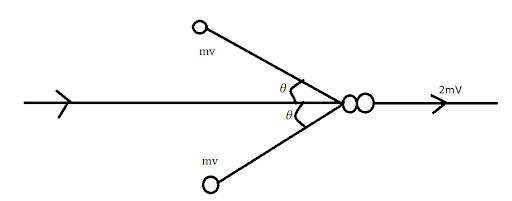
Two bodies of the same mass are moving with the same speed, but in different directions in a plane. They have a completely inelastic collision and move together thereafter with a final speed which is half of their initial speed. The angle between the initial velocities of the two bodies (in degree) is ________.
Answer
219.3k+ views
Hint: We are given two bodies having the same mass moving with same velocity but in different directions in a single plane. After having an inelastic collision, they have a final speed which is half of the initial speed. We have to find the angle between the initial velocities of the two bodies. We will be using conservation of momentum to find out.
Complete step by step solution:
Let the two bodies have \[m\] and velocity \[v\]. Let the angle made by their initial velocities be \[\theta \]and let the final velocity be \[V\]. Let us first draw a figure, that is representing the scenario given in question

Here it is given that
\[V = \dfrac{v}{2}\]
On applying conservation of momentum on \[x\]axis, we get
\[mv\cos \theta + mv\cos \theta = 2mV \\ \Rightarrow 2mv\cos \theta = 2m\dfrac{v}{2} \\ \Rightarrow \cos \theta = \dfrac{1}{2} \\ \Rightarrow \theta = {60^ \circ } \]
The angle between initial velocities is
\[2\theta = 2 \times 60 = {120^ \circ } \\ \]
Therefore the angle between initial velocities of two bodies is \[{120^ \circ }\].
Note: Students may make mistakes while applying the conservation of momentum. Instead of cosine, they may use sine which is wrong. While applying conservation of momentum, we have taken values of momentum for two bodies on the \[x\] axis, so in our equation the cosine term came. Students should not get confused over here as it is known for a line making angle with axes, on \[x\] axis , cosine comes and on \[y\] axis, sine comes.
Complete step by step solution:
Let the two bodies have \[m\] and velocity \[v\]. Let the angle made by their initial velocities be \[\theta \]and let the final velocity be \[V\]. Let us first draw a figure, that is representing the scenario given in question

Here it is given that
\[V = \dfrac{v}{2}\]
On applying conservation of momentum on \[x\]axis, we get
\[mv\cos \theta + mv\cos \theta = 2mV \\ \Rightarrow 2mv\cos \theta = 2m\dfrac{v}{2} \\ \Rightarrow \cos \theta = \dfrac{1}{2} \\ \Rightarrow \theta = {60^ \circ } \]
The angle between initial velocities is
\[2\theta = 2 \times 60 = {120^ \circ } \\ \]
Therefore the angle between initial velocities of two bodies is \[{120^ \circ }\].
Note: Students may make mistakes while applying the conservation of momentum. Instead of cosine, they may use sine which is wrong. While applying conservation of momentum, we have taken values of momentum for two bodies on the \[x\] axis, so in our equation the cosine term came. Students should not get confused over here as it is known for a line making angle with axes, on \[x\] axis , cosine comes and on \[y\] axis, sine comes.
Recently Updated Pages
Two discs which are rotating about their respective class 11 physics JEE_Main

A ladder rests against a frictionless vertical wall class 11 physics JEE_Main

Two simple pendulums of lengths 1 m and 16 m respectively class 11 physics JEE_Main

The slopes of isothermal and adiabatic curves are related class 11 physics JEE_Main

A trolly falling freely on an inclined plane as shown class 11 physics JEE_Main

The masses M1 and M2M2 M1 are released from rest Using class 11 physics JEE_Main

Trending doubts
JEE Main 2026: Application Form Open, Exam Dates, Syllabus, Eligibility & Question Papers

Understanding Uniform Acceleration in Physics

Derivation of Equation of Trajectory Explained for Students

Hybridisation in Chemistry – Concept, Types & Applications

Understanding the Angle of Deviation in a Prism

Understanding Collisions: Types and Examples for Students

Other Pages
JEE Advanced Marks vs Ranks 2025: Understanding Category-wise Qualifying Marks and Previous Year Cut-offs

Units And Measurements Class 11 Physics Chapter 1 CBSE Notes - 2025-26

NCERT Solutions For Class 11 Physics Chapter 8 Mechanical Properties Of Solids

Motion in a Straight Line Class 11 Physics Chapter 2 CBSE Notes - 2025-26

NCERT Solutions for Class 11 Physics Chapter 7 Gravitation 2025-26

Understanding Atomic Structure for Beginners




